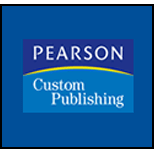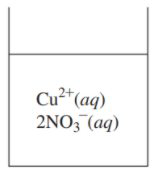
EP BASIC CHEMISTRY-STANDALONE ACCESS
6th Edition
ISBN: 9780134999890
Author: Timberlake
Publisher: PEARSON CO
expand_more
expand_more
format_list_bulleted
Concept explainers
Textbook Question
Chapter 15, Problem 74APP
Copper cooking pans are stainless steel pans plated with a layer of copper. Add the necessary components (electrodes, wires, batteries) to this diagram of an electrolytic cell with a copper(II) nitrate solution to show how it could be used to copper plate a stainless steel (iron) pan.

a. What is the anode?
b. What is the cathode?
c. What is the half-reaction that takes place at the anode?
d. What is the half-reaction that takes place at the cathode?
Expert Solution & Answer
Want to see the full answer?
Check out a sample textbook solution
Students have asked these similar questions
If we have two compounds: acetone (CH3COCH3)
and acetic acid (CH3COOH); if we apply heat (A),
what product(s) are obtained?
QUESTION: Fill out the answers to the empty green boxes attached in the image.
*Ensure you all incorporate all 27 values (per column)*
You need to make a buffer by dissolving benzoic acid and sodium benzoate in
water. What is the mass of benzoic acid that you would weigh out, in mg, to
create 50 mL of a buffer at pH = 4.7 that will change pH no more than 0.10 units
with the addition of 0.001 moles of acid or base?
Enter just the answer without the units (mg) - just the number will do!
Chapter 15 Solutions
EP BASIC CHEMISTRY-STANDALONE ACCESS
Ch. 15.1 - Identify each of the following as an oxidation or...Ch. 15.1 - Identify each of the following as an oxidation or...Ch. 15.1 - Prob. 3PPCh. 15.1 - Prob. 4PPCh. 15.1 - Prob. 5PPCh. 15.1 - Prob. 6PPCh. 15.1 - Prob. 7PPCh. 15.1 - Prob. 8PPCh. 15.1 - Prob. 9PPCh. 15.1 - Prob. 10PP
Ch. 15.1 - Prob. 11PPCh. 15.1 - Prob. 12PPCh. 15.1 - What is the oxidation number of the specified...Ch. 15.1 - What is the oxidation number of the specified...Ch. 15.1 - Prob. 15PPCh. 15.1 - Prob. 16PPCh. 15.1 - Prob. 17PPCh. 15.1 - Prob. 18PPCh. 15.1 - Prob. 19PPCh. 15.1 - Prob. 20PPCh. 15.2 - Balance each of the following half-reactions in...Ch. 15.2 - Prob. 22PPCh. 15.2 - Prob. 23PPCh. 15.2 - Use the half-reaction method to balance each of...Ch. 15.2 - Use the half-reaction method to balance each of...Ch. 15.2 - Use the half-reaction method to balance each of...Ch. 15.3 - Use the activity series in Table 15.3 to predict...Ch. 15.3 - Use the activity series in Table 15.3 to predict...Ch. 15.3 - Prob. 29PPCh. 15.3 - Prob. 30PPCh. 15.3 - Prob. 31PPCh. 15.3 - Prob. 32PPCh. 15.3 - The following half-reaction takes place in a...Ch. 15.3 - The following half-reaction takes place in a...Ch. 15.3 - The following half-reaction takes place in a...Ch. 15.3 - Prob. 36PPCh. 15.4 - What we call "tin cans" are really iron cans...Ch. 15.4 - Prob. 38PPCh. 15.4 - Prob. 39PPCh. 15.4 - Prob. 40PPCh. 15.4 - Prob. 41PPCh. 15.4 - Prob. 42PPCh. 15 - Prob. 43UTCCh. 15 - Prob. 44UTCCh. 15 - Prob. 45UTCCh. 15 - Prob. 46UTCCh. 15 - The chapter sections to review are shown in...Ch. 15 - The chapter sections to review are shown in...Ch. 15 - The chapter sections to review are shown in...Ch. 15 - Prob. 50UTCCh. 15 - Prob. 51UTCCh. 15 - Prob. 52UTCCh. 15 - The chapter sections to review are shown in...Ch. 15 - The chapter sections to review are shown in...Ch. 15 - Which of the following are oxidation-reduction...Ch. 15 - Which of the following are oxidation-reduction...Ch. 15 - In the mitochondria of human cells, energy is...Ch. 15 - Prob. 58APPCh. 15 - Prob. 59APPCh. 15 - Prob. 60APPCh. 15 - Prob. 61APPCh. 15 - Prob. 62APPCh. 15 - Prob. 63APPCh. 15 - Write the balanced half-reactions and a balanced...Ch. 15 - Prob. 65APPCh. 15 - Use the activity series in Table 15.3 to predict...Ch. 15 - Prob. 67APPCh. 15 - Prob. 68APPCh. 15 - Prob. 69APPCh. 15 - Prob. 70APPCh. 15 - Prob. 71APPCh. 15 - In an acidic dry-cell battery, the following...Ch. 15 - Steel bolts made for sailboats are coated with...Ch. 15 - Copper cooking pans are stainless steel pans...Ch. 15 - Prob. 75CPCh. 15 - Prob. 76CPCh. 15 - Prob. 77CPCh. 15 - The following problems are related to the topics...Ch. 15 - The following problems are related to the topics...Ch. 15 - The following problems are related to the topics...Ch. 15 - Prob. 81CPCh. 15 - Prob. 82CPCh. 15 - Prob. 83CPCh. 15 - Prob. 84CPCh. 15 - Prob. 85CPCh. 15 - Prob. 86CPCh. 15 - Prob. 87CPCh. 15 - Prob. 88CP
Knowledge Booster
Learn more about
Need a deep-dive on the concept behind this application? Look no further. Learn more about this topic, chemistry and related others by exploring similar questions and additional content below.Similar questions
- Give the organic product: O A O B Ос ○ D -NH–CH3 + CH3 CH3 NEN C ? A CH3 CH3 NH- CH3 B CH3 CH3 N=N- C CH3 CH3 N=NNH CH3 D CH3 N=N CH3 NHCH3 LNH CHOarrow_forwardFinish the reaction- hand written pleasearrow_forwardGive the organic products: (benzyne) Br ? CH3 + K* :NH, liq NH3 HINT: Two products are formed. Each is a substituted aniline; they are isomers of each other. NH2 II I H₂N. CH3 CH3 III Select one: ○ A. I and II ○ B. I and III O C. I and IV O D. II and III O E. III and IV H₂N CH3 IV CH₂-NH2arrow_forward
- Predict the major products of this organic reaction: HBr (1 equiv) cold ? Some important notes: • Draw the major product, or products, of this reaction in the drawing area below. • You can draw the products in any arrangement you like. • Pay careful attention to the reaction conditions, and only include the major products. • Be sure to use wedge and dash bonds when necessary, for example to distinguish between major products that are enantiomers. • Note that there is only 1 equivalent of HBr reactant, so you need not consider the case of multiple additions. Erase something Explanation Check 2025 McGraw Hill LLC. All Rights Reserved. Terarrow_forwardQ14. Fill this chart: (please refer to ppt notes/browser to answer these questions) What alcohol is also called wood alcohol? What is the common name of ethanol? Draw the structure of phenol and thiophene? Are bigger chain alcohol like heptanol and octanol are soluble or insoluble in water and explain it ? Are ethers soluble or insoluble in water? What suffix and prefix are used for alcohol while naming alcohol and ether? What the process called when we add water to any alkene to make alcohol? Q16. Draw the diagram of following aromatic compound (practice from previous module) Aniline Phenol Benzoic acid Methyl benzoate Q17. a. Write the oxidation reactions for the 2 propanol. b. Write the oxidation reaction of the ethanol.arrow_forwardQuestion 11 of 18 (1 point) Question Attempt: 3 of How many signals do you expect in the 'H NMR spectrum for this molecule? Br Br Write the answer below. Also, in each of the drawing areas below is a copy of the molecule, with Hs shown. In each copy, one of the H atoms is colored red. Highlight in red all other H atoms that would contribute to the same signal as the H already highlighted red. Note for advanced students: In this question, any multiplet is counted as one signal. Number of signals in the 'H NMR spectrum. 1 For the molecule in the top drawing area, highlight in red any other H atoms that will contribute to the same signal as the H atom already highlighted red. If no other H atoms will contribute, check the box at right. No additional Hs to color in top molecule Check For the molecule in the bottom drawing area, highlight in red any other H atoms that will contribute to the same signal as the H atom already highlighted red. If no other H atoms will contribute, check the box…arrow_forward
- Organic Chemistry Esterification reactions 1. Write the steps to prepare ester. 2. Write complete reaction of ethanol and acetic acid to make ester. 3. What does ester smell like? What are the uses of ester. 4. What the role of sulfuric acid in the esterification reactionarrow_forward11. Complete the following esterification reaction with names of all the reactants and products under. Hint: Remove the water and end up with ester R-C-OH + ROH R-C-OR + H₂O A carboxylic acid An alcohol An ester Water BYJU'S H-C-C O-H Нин C-C-C-H HAAA H O-C-C-C-H AAA Ethanoic acid Propanol Water Propyl ethanoate By com CH3COOH + CH3CH2CH2CH₂CH₂OH → Practice for alcohols aldehydes and ketones: 12. Draw the structures from the following names mixed of alcohol/aldehyde and ketone: a. 4-methyl cyclohexanone b. 3-methyl-2-pentenal c. 2,3-dimethylcyclohexanone d. 1,3propanediol or Propane 1,3 diol 13. Write systematic names for the following compounds identify functional group: a. b. (CH3)2CH-C OH c) CH(CH₂)-- OH -,-,arrow_forwardmay you please show all steps! i am having a hard time understanding and applying in this format, thank you!arrow_forward
arrow_back_ios
SEE MORE QUESTIONS
arrow_forward_ios
Recommended textbooks for you
 ChemistryChemistryISBN:9781305957404Author:Steven S. Zumdahl, Susan A. Zumdahl, Donald J. DeCostePublisher:Cengage Learning
ChemistryChemistryISBN:9781305957404Author:Steven S. Zumdahl, Susan A. Zumdahl, Donald J. DeCostePublisher:Cengage Learning ChemistryChemistryISBN:9781259911156Author:Raymond Chang Dr., Jason Overby ProfessorPublisher:McGraw-Hill Education
ChemistryChemistryISBN:9781259911156Author:Raymond Chang Dr., Jason Overby ProfessorPublisher:McGraw-Hill Education Principles of Instrumental AnalysisChemistryISBN:9781305577213Author:Douglas A. Skoog, F. James Holler, Stanley R. CrouchPublisher:Cengage Learning
Principles of Instrumental AnalysisChemistryISBN:9781305577213Author:Douglas A. Skoog, F. James Holler, Stanley R. CrouchPublisher:Cengage Learning Organic ChemistryChemistryISBN:9780078021558Author:Janice Gorzynski Smith Dr.Publisher:McGraw-Hill Education
Organic ChemistryChemistryISBN:9780078021558Author:Janice Gorzynski Smith Dr.Publisher:McGraw-Hill Education Chemistry: Principles and ReactionsChemistryISBN:9781305079373Author:William L. Masterton, Cecile N. HurleyPublisher:Cengage Learning
Chemistry: Principles and ReactionsChemistryISBN:9781305079373Author:William L. Masterton, Cecile N. HurleyPublisher:Cengage Learning Elementary Principles of Chemical Processes, Bind...ChemistryISBN:9781118431221Author:Richard M. Felder, Ronald W. Rousseau, Lisa G. BullardPublisher:WILEY
Elementary Principles of Chemical Processes, Bind...ChemistryISBN:9781118431221Author:Richard M. Felder, Ronald W. Rousseau, Lisa G. BullardPublisher:WILEY

Chemistry
Chemistry
ISBN:9781305957404
Author:Steven S. Zumdahl, Susan A. Zumdahl, Donald J. DeCoste
Publisher:Cengage Learning

Chemistry
Chemistry
ISBN:9781259911156
Author:Raymond Chang Dr., Jason Overby Professor
Publisher:McGraw-Hill Education

Principles of Instrumental Analysis
Chemistry
ISBN:9781305577213
Author:Douglas A. Skoog, F. James Holler, Stanley R. Crouch
Publisher:Cengage Learning

Organic Chemistry
Chemistry
ISBN:9780078021558
Author:Janice Gorzynski Smith Dr.
Publisher:McGraw-Hill Education

Chemistry: Principles and Reactions
Chemistry
ISBN:9781305079373
Author:William L. Masterton, Cecile N. Hurley
Publisher:Cengage Learning

Elementary Principles of Chemical Processes, Bind...
Chemistry
ISBN:9781118431221
Author:Richard M. Felder, Ronald W. Rousseau, Lisa G. Bullard
Publisher:WILEY
Bonding (Ionic, Covalent & Metallic) - GCSE Chemistry; Author: Science Shorts;https://www.youtube.com/watch?v=p9MA6Od-zBA;License: Standard YouTube License, CC-BY
Stoichiometry - Chemistry for Massive Creatures: Crash Course Chemistry #6; Author: Crash Course;https://www.youtube.com/watch?v=UL1jmJaUkaQ;License: Standard YouTube License, CC-BY